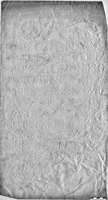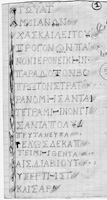 MAMA XI 26 (Eumeneia)
MAMA XI 26 (Eumeneia) 
Honorific statue-base for a local magistrate
[- - - - - - - - - - - - - -]
[.]του Ἀτ[- - - - - - - -]
[Ἀ]μμιανὸν, [πάσας ἀρ]-
χὰς καὶ λειτου[ργίας ἐκ]
προγόνων πα[ρασχόμε]-
5νον, ἱερονείκην [ἄλειπτον (?)]
παράδοξον, βο[υλευτήν],
πρῶτον στρατ[ηγόν], [ἀγορ]-
ανομήσαντα τ[ὴν πρώτην (?)]
τετράμηνον, γρ[αμματεύ]-
10σαντα πολυδ[απάνως],
πρυτανεύσα[ντα πολυ]-
τέλως, δεκάπ[ρωτον],
τειμηθέντα [ξυσταρχί (?)]-
αις διὰ βίου, π[ρεσβεύσαντα]
15ὑπὲρ τῆς [πόλεως πρὸς τὸν]
Καίσαρα̣ [- - - - - - - -]
- - - - - - - - - - - - - -
...Ammianus, having fulfilled (lit. provided) all the offices and liturgies in accordance with the behaviour of his ancestors, an undefeated (?) and extraordinary sacred victor, member of the boule, first strategos, having served as agoranomos for the first (?) four-month period, having served as secretary at great expense, having served as prytane with great generosity, dekaprotos, having been honoured with xystarchies for life, having served as ambassador on the city’s behalf to Caesar...





This honorific inscription greatly increases our knowledge of the public offices of Eumeneia. Hitherto our major source for the civic offices of the city was the inscription IGR IV 739 (Ramsay, Phrygia I 246-7, no. 88 = II 375-6, no. 197), an honorific decree for a certain Monimos, λαμπαδάρχην, ἱ[ερέα Διὸς] Σωτῆρος καὶ Ἀπόλλ[ωνος καὶ] Μηνὸς Ἀσκαηνοῦ [καὶ Μητρὸς] θεῶν Ἀνγδίστεω[ς καὶ Ἀγαθοῦ] Δαίμονος καὶ Εἴσε[ιδος καὶ Σε]βαστῆς Εἰρήνης, σ[τρατηγὸν] τῆς πόλεως τὸ ἕκτον, [χρεοφυλα]κήσαντα καὶ ἐγλογισ[τεύσαντα] καὶ ἀγορανομήσαντα [καὶ εἰρηναρ]χήσαντα καὶ παραφ[υλάξαντα καὶ γραμ]μ[α]τεύ[σαντα]. The new inscription renders it clear that there was a college of strategoi at Eumeneia, presided over by a πρῶτος στρατηγός, as at nearby Laodikeia (I.Laodikeia 45, 70, 134) and Hierapolis (AvH 40, 41). For the Eumeneian strategoi, see also MAMA XI 24 (1954/20: Kocayaka). The normal term of office for an agoranomos seems to have been four months (Quass 1993: 263 n.1067); in line 8, either πρώτην or τρίτην would fit the size of the lacuna. Τhe office of γραμματεὺς (τῆς βουλῆς) is also attested at Eumeneia in Drew-Bear 1978: 68-70, IV 3 (SEG 28, 1116). For the office of δεκάπρωτος, not attested in the province of Asia before the second century AD, see Wörrle 1988: 162-3; Burton 2001: 207-9.
In lines 2-5, the verb παρέχεσθαι is a little unexpected; one would have anticipated πληρώσαντα or (ἐκ)τελέσαντα, as in the Eumeneian inscription Ramsay, Phrygia II 378, no. 204 (τὰς κορυφαιοτάτας ἀρχὰς καὶ λειτουργίας ἀμέμπτως ἐκτελέσαντα). Cf., however, IAph2007 12.203.8-10, πάσας παρασχόμενον τῇ πατρίσι φιλοδόξους καὶ λαμπροτάτας λιτουργίας. For benefactors ἐκ προγόνων at Eumeneia, see also Ramsay, Phrygia II 377, no. 199; Drew-Bear 1978: 70-2, IV 4 (SEG 28, 1118).
In line 5, I have restored the adjective ἄλειπτος, ‘undefeated’; for the combination of this term with παράδοξος, ‘extraordinary’, in the description of athletic prowess, compare e.g. the pancratiast and boxer M. Aur. Demostratos Damas, regularly described as a πύκτης ἄλειπτος παράδοξος (Strasser 2003; e.g. IGUR I 243; SEG 42, 458). The absence of any mention of the particular field in which Ammianus excelled ought not to concern us: cf. e.g. I.Laodikeia 51; TAM II 427 (Patara). On the term παράδοξος, see Robert 1940: 250-2. In the light of Ammianus’ athletic successes, I have supplemented lines 13-14 on the assumption that he was honoured with ‘life-xystarchies’. A xystarch was an athlete appointed for life by the emperor to oversee the discipline of the athletes in one or more contests in a particular city or region (Robert 1966: 82-3). For the phraseology here, cf. e.g. I.Perge 314; I.Anazarbos 25 (a pentathlete, τειμηθεὶς ὑπὸ τῶν κυρίων αὐτοκρατόρων ξυσταρχίαις διὰ βίου). The only athletic contest thus far attested at Eumeneia is that of the Εὐμένηα Φιλαδέλφια (Robert 1937: 164-5; Weiss 2000b: 626-7); for another Eumeneian athlete, the Christian Aurelius Eutyches, surnamed Helix, see Buckler, Calder and Cox 1926: 80-2, no. 204; Robert, Hellenica XI/XII, 423-5.